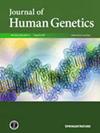GPD1缺乏——一种罕见的,被忽视的肝病病因。
IF 2.5
3区 生物学
Q2 GENETICS & HEREDITY
引用次数: 0
摘要
一过性婴儿高甘油三酯血症是在不明原因的肝酶升高、高甘油三酯血症和肝纤维化的情况下应考虑的疾病之一。我们报告了2例具有瞬时婴儿高甘油三酯血症的GPD1基因新型纯合变异的兄弟姐妹。两名近亲婚姻出生的兄弟姐妹因肝肿大,转氨酶升高和脂肪肝而转诊。排除其他可能的脂肪肝和转氨酶水平升高的原因后;对两例患者外周血中分离的基因组DNA进行全外显子组测序(WES)。全外显子组测序发现了一个新的纯合变异,C .628 G . > C:p。G210R,见GPD1。我们的报告强调了基因组测序在诊断不明原因的儿童脂肪肝疾病和/或酶水平升高中的重要性。在短暂性婴儿高甘油三酯血症患者中,应该使用全外显子组测序来研究GPD1基因的新型纯合变异体。本文章由计算机程序翻译,如有差异,请以英文原文为准。

GPD1 deficiency—a rare, overlooked cause of liver disease
Transient infantile hypertriglyceridemia is one of the diseases that should be considered in case of unexplained elevated liver enzymes, hypertriglyceridemia and hepatosteatosis. We report 2 siblings with novel homozygous variants in the GPD1 gene with transient infantile hypertriglyceridemia. Two siblings born from consanguineous marriage were referred due to hepatomegaly, elevated transaminases and fatty liver. After excluding other possible causes of fatty liver and elevated transaminase levels; whole-exome sequencing (WES) was performed on genomic DNA isolated from the peripheral blood samples of both patients. Whole exome sequencing revealed the identification of a novel homozygous variant, c.628 G > C:p.G210R, in GPD1. Our report underscores the importance of genome sequencing in diagnosing unexplained childhood fatty liver disease and/or elevated enzyme levels. In patients with transient infantile hypertriglyceridemia, investigation into novel homozygous variants in the GPD1 gene should be conducted using whole exome sequencing.
求助全文
通过发布文献求助,成功后即可免费获取论文全文。
去求助
来源期刊

Journal of Human Genetics
生物-遗传学
CiteScore
7.20
自引率
0.00%
发文量
101
审稿时长
4-8 weeks
期刊介绍:
The Journal of Human Genetics is an international journal publishing articles on human genetics, including medical genetics and human genome analysis. It covers all aspects of human genetics, including molecular genetics, clinical genetics, behavioral genetics, immunogenetics, pharmacogenomics, population genetics, functional genomics, epigenetics, genetic counseling and gene therapy.
Articles on the following areas are especially welcome: genetic factors of monogenic and complex disorders, genome-wide association studies, genetic epidemiology, cancer genetics, personal genomics, genotype-phenotype relationships and genome diversity.
 求助内容:
求助内容: 应助结果提醒方式:
应助结果提醒方式:


